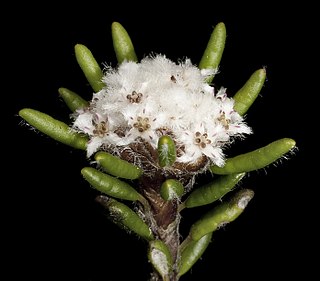Stenanthemum arens is a species of flowering plant in the family Rhamnaceae and is endemic to South Australia. It is a twiggy shrub with broadly egg-shaped to almost circular leaves and heads of 10 to 20 silky-hairy white, tube-shaped flowers, usually with whitish floral leaves.
Stenanthemum bremerense is a species of flowering plant in the family Rhamnaceae and is endemic to the southwest of Western Australia. It is an erect, or low spreading shrub with hairy young stems, broadly egg-shaped leaves and densely hairy heads of tube-shaped flowers, sometimes with whitish floral leaves.
Stenanthemum complicatum is a species of flowering plant in the family Rhamnaceae and is endemic to the southwest of Western Australia. It is a woody, erect or straggling shrub with densely hairy young stems, broadly egg-shaped leaves and densely woolly-hairy heads of tube-shaped flowers.
Stenanthemum coronatum is a species of flowering plant in the family Rhamnaceae and is endemic to the southwest of Western Australia. It is a prostrate shrub with sparsely hairy young stems, broadly egg-shaped leaves and densely shaggy-hairy heads of tube-shaped flowers.
Stenanthemum divaricatum is a species of flowering plant in the family Rhamnaceae and is endemic to the southwest of Western Australia. It is a small, often spiny shrub with sparsely hairy young stems, fan-shaped to narrowly egg-shaped leaves and densely, softly-hairy heads of tube-shaped flowers.

Stenanthemum humile is a species of flowering plant in the family Rhamnaceae and is endemic to the southwest of Western Australia. It is a low, erect perennial herb or shrub with white, woolly-hairy young stems, linear to narrowly elliptic leaves and densely, woolly-hairy heads of tube-shaped flowers.

Stenanthemum intricatum is a species of flowering plant in the family Rhamnaceae and is endemic to the southwest of Western Australia. It is an erect to spreading, often wiry shrub with sparsely hairy young stems, egg-shaped to fan-shaped leaves and greyish, densely softly-hairy heads of white or cream-coloured flowers.
Stenanthemum limitatum is a species of flowering plant in the family Rhamnaceae and is endemic to the southwest of Western Australia. It is an erect or straggling shrub with sparsely hairy young stems, egg-shaped to fan-shaped leaves and greyish, softly-hairy heads of white or cream-coloured flowers.

Stenanthemum leucophractum, commonly known as rusty poison, white cryptandra or white stenanthemum, is a species of flowering plant in the family Rhamnaceae and is endemic to south-eastern continental Australia. It is a spreading shrub or subshrub with softly-hairy young stems, egg-shaped to fan-shaped leaves and heads of white or yellowish flowers surrounded by white, felt-like floral leaves.
Stenanthemum mediale is a species of flowering plant in the family Rhamnaceae and is endemic to inland Western Australia. It is an erect shrub with densely hairy young stems, egg-shaped leaves and densely hairy heads of silvery to rust-coloured flowers.

Stenanthemum nanum is a species of flowering plant in the family Rhamnaceae and is endemic to the south-west of Western Australia. It is a prostrate shrub with hairy young stems, broadly egg-shaped leaves with the narrower end towards the base, and densely silvery-hairy heads of white or cream-coloured flowers.
Stenanthemum newbeyi is a species of flowering plant in the family Rhamnaceae and is endemic to a restricted area in the south of Western Australia. It is an erect or spreading shrub with hairy young stems, egg-shaped leaves with the narrower end towards the base, and clusters of rust-coloured, densely shaggy-hairy flowers, surrounded by whitish floral leaves.
Stenanthemum notiale is a species of flowering plant in the family Rhamnaceae and is native to Western Australia, South Australia and Victoria. It is a small, erect to prostrate shrub with hairy young stems, egg-shaped leaves with the narrower end towards the base, and clusters of white to cream-coloured or greenish yellow, densely shaggy-hairy flowers.
Stenanthemum patens is a species of flowering plant in the family Rhamnaceae and is endemic to the inland of Western Australia. It is a small shrub with densely hairy young stems and a few spines, egg-shaped to broadly egg-shaped leaves with the narrower end towards the base, and densely hairy clusters of tube-shaped flowers.
Stenanthemum petraeum is a species of flowering plant in the family Rhamnaceae and is native to inland Western Australia and the Northern Territory. It is a woody, erect shrub with densely hairy young stems, broadly egg-shaped to more or less round leaves, and clusters of white, densely shaggy- to woolly-hairy flowers.

Stenanthemum pimeleoides, commonly known as spreading stenanthemum or propellor plant, is a species of flowering plant in the family Rhamnaceae and is endemic to Tasmania. It is a small, prostrate, mat-forming shrub with hairy young stems, egg-shaped leaves with the narrower end towards the base, and densely hairy clusters of tube-shaped flowers surrounded by conspicuous, whitish floral leaves.

Stenanthemum pomaderroides is a species of flowering plant in the family Rhamnaceae and is endemic to the southwest of Western Australia. It is an erect shrub with densely hairy young stems, egg-shaped leaves with the narrower end towards the base, and cream-coloured clusters of 10 to 30 tube-shaped flowers.

Stenanthemum pumilum is a species of flowering plant in the family Rhamnaceae and is endemic to the southwest of Western Australia. It is a low, compact shrub with hairy young stems, egg-shaped leaves, sometimes with the narrower end towards the base, and clusters of 10 to 30 white to creamy-white, woolly hairy, tube-shaped flowers.

Stenanthemum reissekii is a species of flowering plant in the family Rhamnaceae and is endemic to the south-west of Western Australia. It is an erect or low-lying shrub with hairy young stems, egg-shaped or narrowly egg-shaped leaves with the narrower end towards the base, and clusters of densely hairy white or cream-coloured flowers.
Stenanthemum stipulosum is a species of flowering plant in the family Rhamnaceae and is endemic to inland Western Australia. It is an erect or low-lying shrub with densely hairy young stems, egg-shaped with the narrower end towards the base, and clusters of 10 to 30 densely hairy white or cream-coloured flowers, sometimes surrounded by whitish floral leaves.







